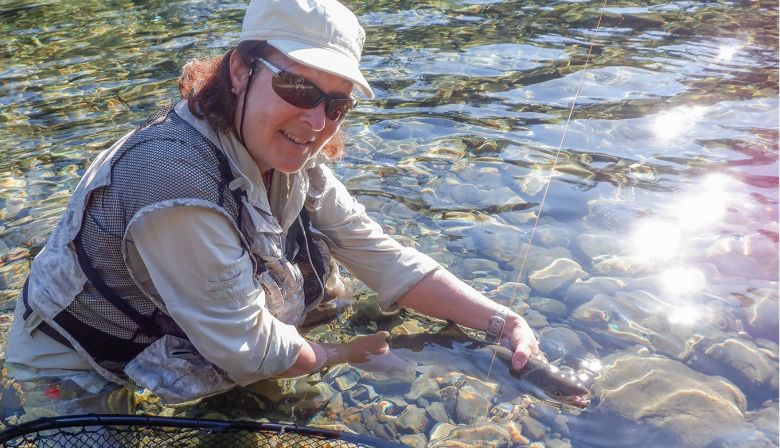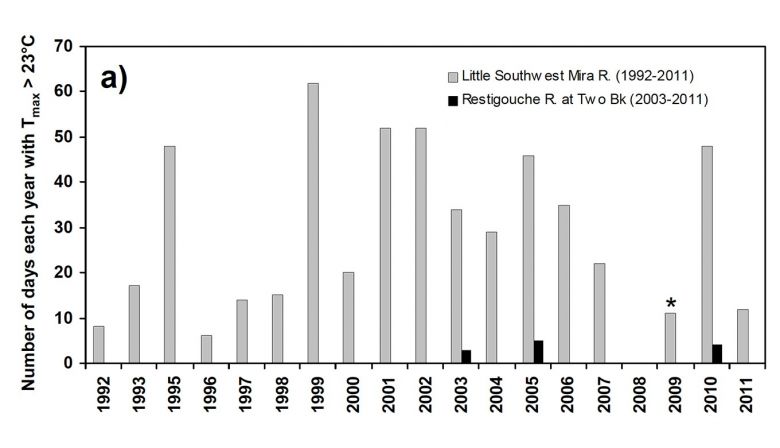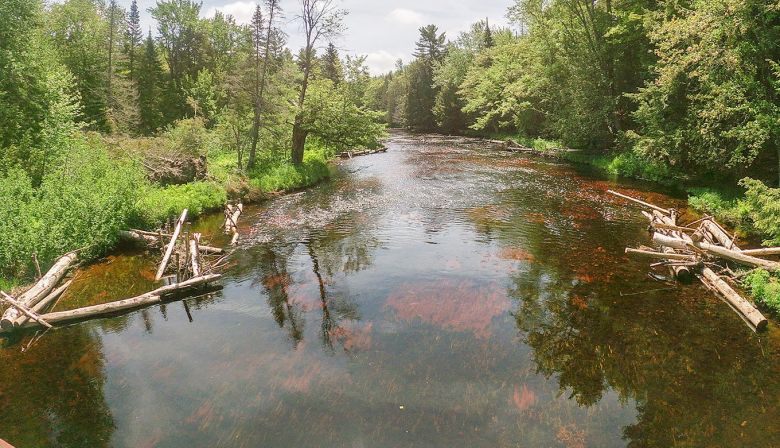
Subscribe & stay up-to-date with ASF


However, at any time in the summer there are general rules to follow that can significantly reduce mortality associated with live release: take control of your catch and land fish quickly, keep them wet and limit the time they are exposed to the air, if at all.
Cooling the Streams
In addition to responsible and respectful angling, there are things we can do to enhance and safeguard the cold water entering our rivers.
To learn more, check out this blog written in blog written in April by Nathan Wilbur entitled Thermal Refuge
You can check out the background to the warm water protocols in NB, NL and on the Margaree:
DFO Gulf Region NB:
https://waves-vagues.dfo-mpo.gc.ca/Library/346488.pdf
DFO NL
https://waves-vagues.dfo-mpo.gc.ca/Library/348302.pdf
Margaree River
https://www.margareesalmon.ca/2019/06/29/2019-warm-water-protocol/
To check out the various orders, go to this page:
http://www.glf.dfo-mpo.gc.ca/Gulf/FAM/Recreational-Fisheries/Salmon
Keep the best interest of the Atlantic salmon at heart.




Fisheries and Oceans Canada wishes to inform the public that the 27 salmon fishing pools in the Miramichi River system, reopened since July 17, 2020 due to improvement of water conditions, will be closed to angling for all species of fish due to warm waters. This closure will start Tuesday, July 21, 2020 and will remain in place until conditions improve, as per the strategy implemented in cooperation with local partners to respond to warm waters conditions.
Reminder: please note that the three following pools will remain closed until December 31, 2020:
The numbers of returns to Mactaquac are again dismal. There were 101 large salmon to July 15, 2020 compared with 164 in the previous year. The average from 1997 to 2001 was 789.
There were just 192 grilse to the same date compared with 378 in 2019. The average for 1997 to 2001 was 1,575.
Perhaps it is instructive to see how concerning the numbers are when compared to a harvest overview for the years up to 1981. As we are all aware, numbers have dropped to levels critical so that live release only needs to be enforced. See below


These numbers are still low, but the improvement in large salmon is an excellent move. Is it due to the improvement in monitoring of harvests in West Greenland?
The Dungarvon Barrier, a measure for the Southwest Miramichi, has had 57 large salmon and 66 grilse to July 19, very slightly ahead of last year’s 60 grilse and 53 large salmon.

Nathan Wilbur, ASF Director of New Brunswick Programs, says:
The good news is that there continues to be positive reports coming in.
People are seeing salmon on the move on the Miramichi and Restigouche, and when conditions are good (meaning when the water cools overnight), people are catching fish as well.
The bad news is that it appears poachers have caught on that fewer conservation officers are in the woods this summer.
Many of our provincial wardens are working the borders this summer as part of the Covid-19 response. Unfortunately, anglers have been seeing a fair amount of poaching activity. The agencies are relying on intelligence to help target areas.
If you notice any suspicious signs – empty worm containers, tackle boxes, salmon scales on the bank, nets stashed in the woods – please contact your local DNR and DFO enforcement offices (phone numbers in the NB Fish Book). They need your clues to help piece together the puzzle to catch poachers. Once a few people have been busted, the message gets out.
The warm water protocol for the Nepisiguit, Miramichi and Restigouche kicks in and out so please keep an eye out for changes related to fishing restrictions in your area. And, as usual, we’ll all keep doing the rain dance, wet weather is always welcomed!


Charles Cusson, ASF Director of Quebec Programs writes:
Angling results have declined in the last week due to most rivers still dealing with low water levels and higher temperatures. Numbers continue to be very encouraging on rivers such as the Matane, Madeleine, Mitis and Matapedia.
Author of the book La rivière Bonaventure 1883-1980, Chantal Morin, recently spent time on the Bonaventure reporting very good angling in Sector E of this beautiful river while during the same period of time, 12 years old angler Nicolas Drohan from the town of Gaspé with the help of his grandfather Donald Bourgouin hooked, landed and released his first ever Atlantic salmon.
Reminder to anglers fishing Quebec Rivers, take the time to report your releases to have the most accurate angling statistics so the river managers to accurately calculate angling success.
Tight Lines!
Editor note: Data used in this report are sourced from various river websites, social media and Quebec government sources.
Les données en provenance des rivières comme la Matapédia, Madeleine, Mitis et Matane sont encore encourageantes a date, le succès de pêche a diminué quelque peu dû aux débits qui sont à la baisse et les températures d’eau plus chaude. Dernièrement, l’auteur du livre intitulé « La rivière Bonaventure 1883-1980, Chantal Morin, a eu la chance de taquinée le saumon dans le secteur E de cette magnifique rivière avec succès tandis que Nicolas Drohan avec l’aide de son grand-père Donald Bourgouin a pêché son premier saumon a vie sur la rivière Madeleine.
Rappel aux saumoniers pêchant les rivières du Québec, prenez le temps de rapporter vos prises et remise à l’eau afin d’avoir des statistiques précises et que les gestionnaires de rivière puissent calculer le succès de pêche avec précision.
Les données utilisées dans ce rapport proviennent de divers sites Web, médias sociaux et des sources du gouvernement du Québec.

Local resident and friend of the Atlantic salmon Garland Nadeau is reporting some of the best angling ever. Overall, the great run of fish started 10 days early in June with excellent numbers of large salmon and followed by a very good grilse run (especially the 6-pound component that are famous on this river) being angled as well as being observed.
Mr. Nadeau is a proud resident of St-Paul River on the lower north shore of Quebec and is very conscious of the salmon resources’ fragility in the face of the Caplan fishery in and around the St-Paul archipelago. “The purse seiners are out there too close to shore at the same time the smolts are heading out to sea and these are undoubtedly being caught by the commercial fisherman,” says Mr. Nadeau. He has been a great help to the MFFP and DFO staff, keeping them informed on human activity in fresh and salt water in his area of salmon country.
Monsieur Garland Nadeau, ami du saumon atlantique partage le fait que la pêche sportive cette année est excellente sur sa rivière préférée. La montaison hâtive d’environ 10 jours plus tôt que d’habitude s’est démarquée par la présence d’un nombre accru de grands saumons suivis d’une excellente montée de madeleineaux (surtout la catégorie de 6 lb qui est renommée sur la rivière Saint-Paul).
Résident de longue date du village de rivière Saint-Paul situé le long de la basse côte nord du Saint-Laurent, monsieur Nadeau est éveillé au fait que la ressource saumon est très fragile face aux activités des seineurs commerciaux de capelan, que d’après lui, pêchent trop proches des berges et des endroits où les saumoneaux entreprennent leurs périples vers la mer. Il est également quelqu’un qui ne se gêne pas de communiquer avec les agents du MFFP et du MPO lorsqu’il observe des activités douteuses qui peuvent nuire au saumon atlantique sauvage.
Rivières York, Dartmouth, Saint-Jean Rivers
The most up to date results are available at:
https://saumongaspe.com/en/peche-saumon-gaspe/statistiques.html
Les statistiques les plus récentes sont disponible au :
https://saumongaspe.com/en/peche-saumon-gaspe/statistiques.html

Rivière Causapscal River
Another season has come to an end as of July 15th. For the season, a total of 140 fish were reported landed of which 55 were released.
In 2019 at season’s end, 181 fish had been landed including 70 releases. Anglers landed 166 fish in 2018 of which 63 had been released.
La saison de pêche sportive sur la Causapscal s’est terminée le 15 juillet. Cette année les saumoniers ont déclaré 140 prises. Le total comprend 55 saumons qui ont été remis à l’eau. Comparativement au 15 juillet 2019 lorsque 181 prises fut enregistré dont 70 saumons remis à l’eau. Les résultats de 2019 se comparent très étroitement aux chiffres de fin de saison en 2018, 166 prises furent déclarées, dont 63 saumons relâchés.
Rivière Matapedia River
To July 20th for the season, 571 salmon have been reported landed including 445 released and 126 grilse harvested.
Last season to July 21st, 608 fish had been landed (415 released and 193 grilse harvested).
À ce jour, le succès de pêche continue d’être encourageant, au 20 juillet, 573 prises cumulatives ont été déclarées, dont 451 saumons relâchés et 128 madeleineaux récoltés.
La saison dernière, cumulativement au 21 juillet, 608 prises furent déclarées (415 saumons relâchés et 193 madeleineaux récoltés).

As of July19th for the season, 1,469 fish (1,050 salmon and 419 grilse) have migrated through the fishway.
To July 19th 2019, 807 salmon and 345 grilse had been counted for total of 1,152. Regarding fish landed by anglers to date in 2020, the SOGERM is reporting a total of 160 fish (142 salmon and 18 grilse released, 72 grilse harvested).
To July 19, 2019, 119 fish (126 salmon and 19 grilse released, 74 grilse harvested) had been reported landed.
Au 19 juillet, 1 469 poissons (1,050 saumons et 419 madeleineaux) furent dénombrés par le biais de la passe migratoire. Au 19 juillet 2019, 807 saumons et 345 madeleineaux avaient été dénombrés pour un total de 1,152.
En ce qui concerne les prises à ce jour en 2020, la SOGERM fait rapport d’un total de 160 poissons (142 saumons et 18 madeleineaux relâchés, 72 madeleineaux récoltés).
Au 19 juillet 2019, 119 prises furent déclarées (126 saumons et 19 madeleineaux relâchés, 74 madeleineaux récoltés).
Rivière Mitis River
To July 20th, at total of 1,117 fish have been transported upriver (613 large salmon and 504 grilse). In comparison to 2019 at the end of season on September 30th, 976 fish (503 salmon 473 grilse) had been relocated upriver.
To date in 2020, 58 salmon have been released and 54 grilse harvested. As of July 22nd, for the season last year, 25 salmon had been released and 27 grilse harvested.
Au 20 juillet 2020, les gestionnaires de la Mitis sont plus que satisfaits des résultats de montaison et la performance du nouveau piège de capture. À date, 1 117 poissons furent transportés en aval du site de capture, dont 613 grands saumons et 504 madeleineaux.
Au 20 juillet, les résultats de pêche cumulatifs indiquent que 58 saumons furent relâchés et 54 madeleineaux récoltés. Comparativement au 22 juillet 2019 lorsque 25 saumons furent déclarés relâchés et que 27 madeleineaux avaient été récoltés.

To July 20th, 1,000 fish have been counted migrating through the fishway (584 large salmon and 416 grilse.
This season’s numbers compare favourably to the same date in 2019 when a total of 383 fish (277 large salmon and 106 grilse) had been counted.
Cumulativement au 20 juillet 2020, 1 000 poissons ont migré par le biais de la passe migratoire, dont 584 grands saumons et 416 madeleineaux).
À la même date en 2019, cumulativement, 383 poissons furent dénombrés, dont 277 grands saumons et 106 madeleineaux.
Rivière Bonaventure River
This season to July 18th, 612 fish have been reported landed including 416 salmon released and 196 grilse that were harvested. In 2019 on July 20th, to date, 569 fish had been reported landed including 460 salmon released and 109 grilse harvested.
Cette saison au 18 juillet, jusqu’à ce jour, 612 prises ont été déclarées dont 416 saumons remis à l’eau et la récolte de 196 madeleineaux.
Cumulativement au 20 juillet 2019, les saumoniers avaient déclaré 569 prises, dont 460 saumons remis à l’eau et 109 madeleineaux récoltés.


That aside, there are a number of encouraging observations to be made.
The Exploits is back. With nearly 15,000 returns to July 19, that is more than double last year’s 6,184 to the same date. Certainly the Exploits should be considered one of the five rivers with highest salmon returns in North America, at least in the past decade.
Rattling Brook with 374 this year vs 26 last year needs to be given some applause.
Terra Nova had a surprisingly good year in 2019, and is following that with another good year in 2020 – 2,218 to July 19
But east coast and south coast Newfoundland streams are worrisome in their low numbers this year. Northeast River (Placentia) has 135 vs 209 last year.The Garnish has 31 vs 188. The Conne on the south coast has only 110 to July 19, vs 383 last year, and 1984 to 1991 averages of 5,884.
For the Conne, that is less than 2 per cent of the returns in that 1984 to 1991 period. The fact the genetics have been compromised by addition of aquaculture escapees certainly needs to be considered as a large component of this 98 per cent decline.
On the west coast, Little Barachois Brook has 689 vs 362, and seems to go with anecdotal information that Bay St. George Rivers are dong well in 2020.
Western Arm Brook also is having a better year, with 304 to July 19, vs 158.
Alas, both Harry’s River and Torrent River have fallen victim to Covid-19 health and safety protocols.


Beyond that, both barrier counts to July 19 and anecdotal information is encouraging.
With English Bay Brook at 34, compared with zero in 2019, with Muddy Bay Brook at 139 vs. 47, and Paradise River at 93 vs 9, the returns are looking up compared with last year.

Pratt Falls Lodge is reporting heat – and salmon. This is their most recent report, from this week:
We have been in a heat wave for days now. Air temps in the low to mid 30s C every day.
I’m a bit surprised with the flow of the river. It is holding up very well. Still above 2m and while the mid day water temps peak around 70-72F, the temp was reading at 66F this morning.
There is a healthy run of grilse on with a mix of about 15 per cent large. Everyone is hooking up and most boats are getting the limit every day. That action is taking place in the early morning and evening.
There’s no sense beating water in the mid day heat when good success can be had in the cooler mornings and evenings. A good nap in air conditioned comfort and cold beverages is how most afternoons are spent in the heat.
There are showers forecast for Goose Bay today and cooler temperatures and showers forecast for all the plateau for this weekend. Hopefully that brings the temperatures down to be just in time for the building of the tides. That will likely bring a good run of fish!


Penobscot River
Jason Valliere, Biologist with Maine Depart of Marine Resources, says:
We are still seeing salmon and a few shad at the Milford lift.
River temperature is 78 F today. Gates are open for free passage, and count is by video camera when we are not on site. We are still trying to collect broodstock although the run has slowed way down. We have sent 3 of the 4 fish captured while the trap/sort was operational as brood this week thus far.
Salmon return estimate is up to 1,415 salmon, by far the best year since 2011.
A total of 216 salmon (185 MSW and 31 Grilse) have been sent to Craig Brook National Fish Hatchery for broodstock.

Narraguagus
Colby Bruchs, Maine DMR Biologist says:
It appears drought conditions are here to stay Downeast.
Discharge on the Narraguagus River has dropped below 70 cfs. Water temperature has remained steady this week; 21-23 C. We captured 3 new returns this week, all large salmon, including our 100th return to the fishway trap in 2020.
The 100th return was our 18th naturally-reared return captured this season, resulting from egg planting, fry stocking, or natural reproduction.
The salmon was released to the river by Project SHARE staff; a vital NGO partner performing habitat restoration projects in the Upper Narraguagus River and other rivers throughout the Downeast Coastal SHRU.
SHARE staff often assist with daily trap tends at our adult trap and smolt traps. We are very pleased that they were on hand to document the return that sent this year’s count to triple digits.
The year 2020 marks the second year since 1991 in which adult salmon captures totalled 100 or more. Total capture to date is the highest capture total since 2011, when there were 196 counted.
